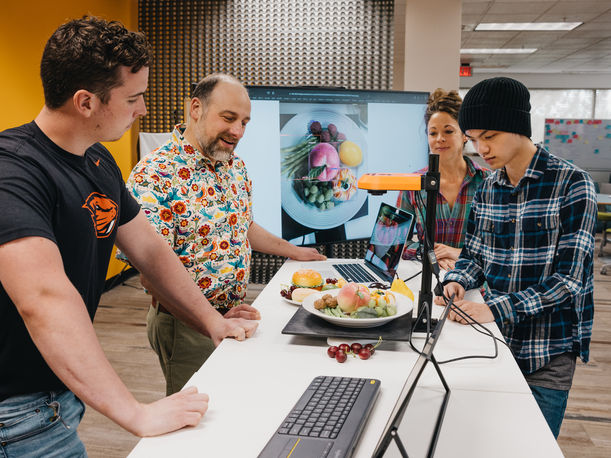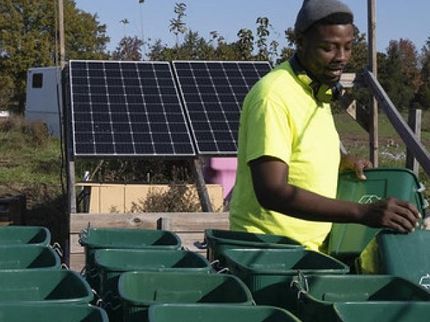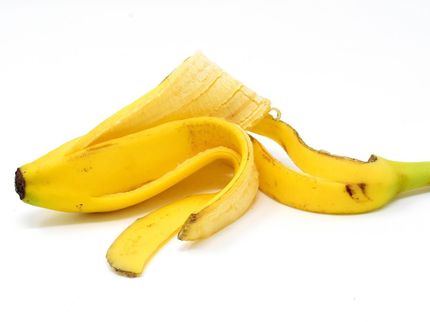AI solution to capture and reduce food waste in households
A researcher at Oregon State University-Cascades has received funding to develop a smart compost bin that tracks household food waste.

OSU-Cascades computer science faculty member Patrick Donnelly, second from left, with OSU-Cascades juniors Micah Stalberg, Kimberly Markley and Daniel Lau (photo by Robert Gill)
Robert Gill
The project led by Patrick Donnelly, assistant professor of computer science in the OSU College of Engineering, seeks to make a dent in a multi-billion-dollar annual problem in the United States: More than one-third of all food produced in the U.S. goes uneaten.
“At every other step of the agricultural supply chain, food waste is tracked, measured and quantified,” Donnelly said. “However, approaches to measuring post-consumer food waste are costly, time-intensive, prone to human error and infeasible at a large scale.”
Donnelly and OSU colleagues Jason Clark of the College of Engineering and Quincy Clark of the colleges of Agricultural Sciences and Education are aiming to create a kitchen compost container that automatically measures household food waste.
“We’re adapting our design to accommodate consumers’ current behavior, using compost bins commonly distributed by waste utilities as a template,” said Donnelly, whose team is receiving $640,000 in funding. “When a user disposes of edible and non-edible food waste in the bin, our device prompts the user to describe the deposited items. The user’s note is then transcribed with automatic speech recognition and associated with a weight measurement of the items.”
Additionally, he said, the device will collect 3-D images and sensor measurements of the food waste, resulting in an “entirely novel dataset to enable and encourage future researchers to tackle the problem of food waste measurement with computer vision.”
This research is supported by the Foundation for Food & Agriculture Research and the Kroger Co. Zero Hunger | Zero Waste Foundation. Roughly 37% of U.S. food waste occurs in homes, according to the FFAR.
In an average year the United States – a country in which more than 10% of households are food-insecure – wastes more than $400 billion worth of food. Aside from economic inefficiency and the moral disaster of discarding food while many people go hungry, Donnelly said, that waste generates significant amounts of the greenhouse gases carbon dioxide and methane.
“There’s a familiar adage: You can’t manage what you don’t measure,” Donnelly said. “Our goal is to inspire future waste reduction by specifically quantifying, measuring and tracking the amount of food that home consumers send to compost.”
As part of the project, researchers will run a small pilot study, likely in spring 2024, he added.
“After we design the device, we will distribute them to study participants,” Donnelly said. “The purpose of the preliminary study is to test the technology and collect measurements and images for a dataset.”
At present this type of food waste research is performed by tasking small groups of participants to manually weigh their food waste and record the measurements in a journal, Donnelly said.
“Our solution would fully automate this process, enabling researchers to collect this data more accurately and efficiently,” he said. “Our work is a first step towards developing a fully autonomous, computer vision solution that would enable households to track the amounts and types of food compost waste they generate. With these personalized and data-driven interventions, we hope to inspire consumers to reflect upon and change their behaviors with respect to food waste over time.”
The Foundation for Food & Agriculture Research was established in the 2014 Farm Bill to increase public agriculture research investments, fill knowledge gaps and complement the U.S. Department of Agriculture’s research agenda. FFAR projects match federal funding with private funding with the aim of establishing collaborations and partnerships that advance actionable science benefiting farmers, consumers and the environment.






























































